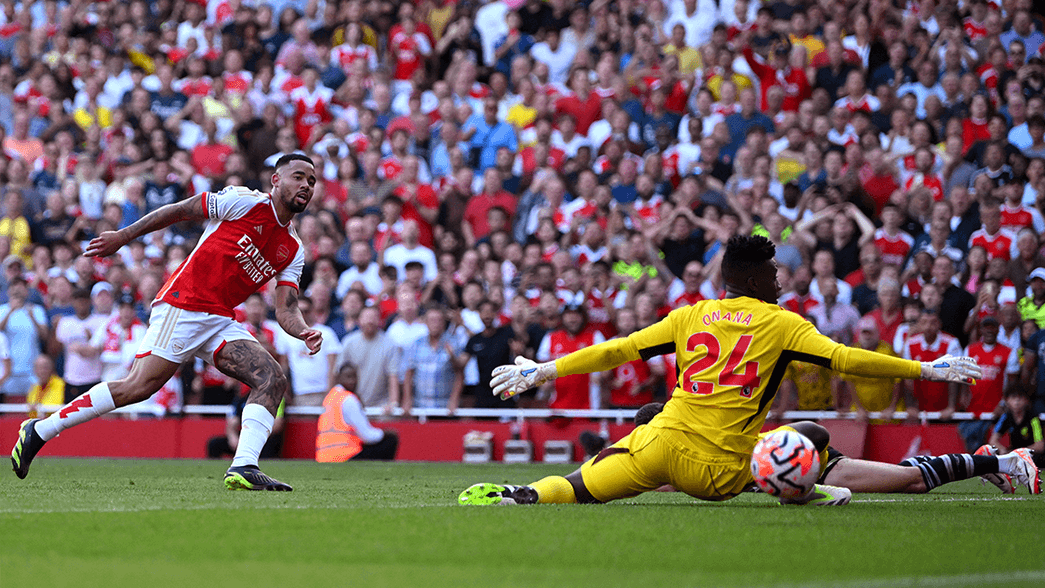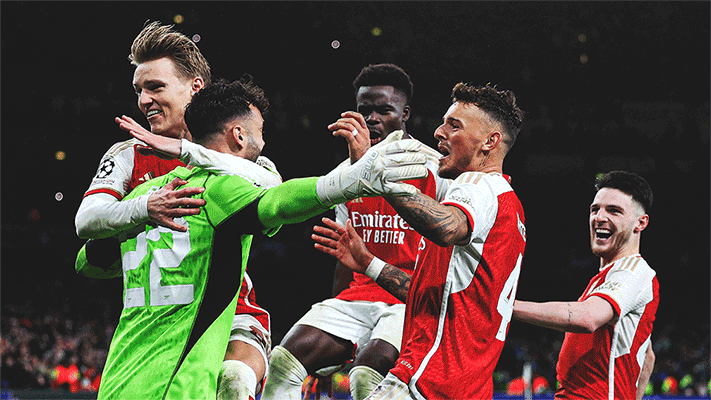Sunday's 3-1 win against Manchester United was an afternoon many Gooners will struggle to forget for years to come, but did you spot some of the key things that led us to the three points?
Adrian Clarke has dissected the game again to highlight five key things that helped us overcome Erik ten Hag's team and record our third win from four to kick off the campaign.
1. Territorial domination
Over the course of this match we did not have to deal with any periods of sustained pressure from ten Hag’s team, who relied almost solely on counter-attacks to create opportunities. Content to sit deep and move the ball to one another, often without gaining ground, 61.7 per cent of Manchester United’s passes were made inside their own half.
Retaining a compact shape when we pressed, rarely did Mikel Arteta’s men allow the visitors to play through the thirds, and consequently, the visiting forwards were starved of service.

As displayed on this Action Areas chalkboard, the bulk of play occurred inside United territory, where our pressure eventually forced cracks. Interestingly, we enjoyed a significantly smaller share of touches inside the final third (28 per cent) against Nottingham Forest on the opening weekend than we did when facing our big rivals United on Sunday (39 per cent).
We may have won the game late on with a pair of injury time goals, but our dominance was irrefutable. Completing more than three times as many passes inside the final third (168-47) our opponents had their second-lowest share of passes in that domain (12.2 per cent) in a Premier League match since records began in 2006/07.
2. Nketiah dragged his markers around
Part of United’s tactical gameplan was to set their central defenders the task of following Eddie Nketiah touch-tight, even if he dropped off into midfield to link play. The downside of that strategy meant that holes were occasionally left in the heart of their defence, which our midfielders or wide forwards could surge into if we found the right pass.
We had to wait until the 59th minute for a chance to hurt them in this way, and it resulted in a penalty kick initially being awarded in our favour.

In the still above, you'll see that Victor Lindelof has followed Nketiah into midfield, after receiving a pass from Declan Rice – a move that inadvertently opened up space for Kai Havertz to run into between Aaron Wan-Bissaka and Casemiro. Nketiah also drew a second-half booking from Lisandro Martinez in a similar way. The 24-year-old dropped short to link play near the halfway line, before being cleaned out by the frustrated Argentine.
3. Left-sided synergy
The dynamic between Gabriel, Oleksandr Zinchenko, Kai Havertz and Gabriel Martinelli was excellent. Three of those four linked up delightfully in the build-up to Martin Odegaard’s outstanding first-half equaliser, in a move reminiscent of last season’s fluid football down that flank.
The presence of two returning left-footers (Gabriel and Zinchenko) seemed to help us feed the ball quicker into the feet of Martinelli. As you can see from his numbers, he was able to impact this clash more effectively than in our previous two home matches:
|
Receiving passes in better areas, with teammates looking to combine with him in close proximity, the Brazilian impressed.
4. Corner kick overload
We scored from our 12th and final corner of this match, and it arrived courtesy of a well-thought-out plan. Up until that stage our best two flag kick routines were clever short corners, but in general our ‘regular’ set plays did not produce accurate enough deliveries.
In the 96th minute however, as shown below, we finally exploited one of the 4v2 set-ups we had been attempting to profit from at the far post.

Missing out a host of zonal markers at the near post, Saka’s cross bypassed everyone including United’s two man-markers who were caught up in tussles with Gabriel and Takehiro Tomiyasu. This provided Rice with enough space to control the ball and shoot on goal.
5. Rice to the rescue

Man of the match by some distance was Rice. Performing with authority and class inside the engine room, our number 41 was a dominant figure with and without the ball.
His positioning and reading of the game denied United the chance to break our lines as often as they would have liked, and on the ball Rice’s choice of pass was terrific. While we were not at our buccaneering best, his calming presence had a positive impact on the team’s overall performance.
|
As well as these, he won all his aerial duels plus four of his five ground duels, and regained possession on nine other occasions. His vital goal capped an individual display that oozed big match confidence, so Rice should be pleased with his afternoon’s work.
Have a go at your own analysis by digging deeper into the numbers or building your own chalkboard with our revamped Stats Centre
Copyright 2024 The Arsenal Football Club Limited. Permission to use quotations from this article is granted subject to appropriate credit being given to www.arsenal.com as the source.











